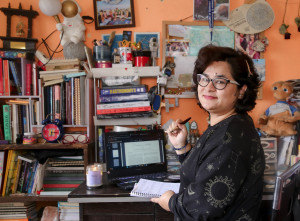Culture & Lifestyle
Ananta Wagle: If you want to raise your children to be readers, you need to invest your time
Wagle, a quality reading material expert, on the importance of instilling reading habits in children.
Srizu Bajracharya
More than a year into the pandemic, children are still at home and away from the communal environment of schools and classrooms. For parents, explaining to their children about the Covid-19 world has been a daunting task.
Ananta Wagle is a quality reading material expert with Room to Read—an organisation that focuses on the literacy development of children. Wagle believes stories are the best way to make children understand the dynamics of the Covid-19 stricken world.
As part of the project ‘Children during the time of Covid-19’, Wagle’s organisation recently launched two children’s books in the Nepali language—‘Tiger ko Naya Ghar’ by Tanka Chaulagain and ‘Chalk ra Patiko Gau Yatra’ by Bhabasagar Ghimire. The books will soon be available at Room to Read’s e-library. In ‘Tiger ko Naya Ghar’, a dog finds a new safe place for itself amidst the uncertainty of the pandemic that has torn the lives of its previous caretakers and two friends. In ‘Chalk ra Patiko Gau Yatra’, a chalk and blackboard from a local village school visit their school friends at their homes and give them books to read.
The books with their narration and artistic illustrations simplify the understanding of how the virus has affected people. They discuss the emotions and difficulties people are facing in a way children can comprehend and the importance of kindness, which the world needs right now.
In this interview with the Post’s Srizu Bajracharya, Wagle, who was the editor of the two storybooks, talks about the importance of instilling reading habits in children.
Excerpts:
As a reading expert, can you tell us a bit about your role in teaching reading? And do you think Nepal's education system places importance on reading?
Children understand the world better with stories, and it’s easier to start a conversation with them when you can show them characters they can understand and relate to. I grew up listening to stories and that has made all the difference to how I see the world. And I love my work because it allows me to work on shaping the mindset of children.
My work requires me to oversee children’s reading experience, looking into the nuance of how a child would comprehend information in a book and their fluency in understanding the book’s subject matter. I also write and edit children's stories and sometimes provide reading training and manage materials children need for quality reading. I also advocate why it’s essential to get children to read.
Frankly speaking, we don’t have a reading culture in the country. Although things are changing, and more people understand why we need to nurture a reading habit in children, our education system still falters in making reading activity a critical engagement in our growing years. The sorry state of government-run libraries is enough to tell that nurturing reading habits of the public, let alone children, has never been a priority for the government or the education system.
Educating children is not just about acquainting them with course books. For children to know the world and engage with it better, they need to be introduced to books beyond their subject books. And that understanding is still missing in parents, teachers and education institutions.
Why is it essential to nurture reading habits in children?
There are so many things to learn about in life that even a lifetime is not enough to cover everything. The education systems’ various curricula are designed to meet certain specific goals, a defining knowledge, but in the school of life, learning is never-ending, and it is our reading habit that will take us places.
When you nurture a child to read, you teach them to be confident and inculcate a habit to understand things deeply. You help them understand words, their sounds and meanings. And when they gradually develop their fluency in reading, they will be better at comprehending things in life. They will be able to grasp more knowledge and communicate with information to express themselves better. Reading invigorates imagination and curiosity. It helps them expand their understanding of the world.
The knowledge gained by reading stories helps a child understand and feel what sadness, happiness and all the emotions people go through in life are. And it is usually stories and literature that help children realise their interests, talents and what they want to do in life. Stories help children in being their better selves.
Is it important to speak with children about Covid-19 and what it means?
Our general instinct is to keep children away from problems. We don’t usually communicate with them about difficult situations. But to raise children with an awareness of their activities and the sensitivity of the social world, we need to communicate with children as we do with adults. The more we are able to talk about the pandemic with them, the more we will be able to protect them.
In our culture, we tend to overprotect our children by curbing their understanding of difficult things in life. But that has to change. We need to be able to talk to our children about the times we are living in if we want to understand what they are going through as well. And that is also why we need children’s books and contents that help children comprehend the times we are living in. When you engage them in these conversations, they will be better at tackling life and they will be more empathetic. Moreover, they will understand the dos and don’ts of the pandemic better.
Our books ‘Tiger ko Naya Ghar’ by Tanka Chaulagain and ‘Chalk ra Patiko Gau Yatra’ by Bhabasagar Ghimire address difficult and emotional conversations of abandonment, illness, sadness, anxiety, isolation, fear, hunger in relation to the pandemic. We believe these stories will open them up for conversations that have been difficult for parents to explain and provide information to children that will give them a better understanding of the times we are living through.

In Bhabasagar’s book ‘Chalk ra Patiko Gau Yatra’ and Tanka Chaulagain’s ‘Tiger ko Naya Ghar’ the main characters are not human but fictional characters. Do characters like these speak more to children?
Yes, that’s true. Both these stories use fictional characters and create a colourful fantasy world to mirror the problems of the real world and that’s because a child’s mind is full of imaginations and they remember better when the characters in the books are fun. We believe imaginative stories affect their understanding in a more effective way. Interactive characters such as a talking chalk and board, and dogs with human emotions help children grasp stories better. The conflict in the story and characters’ actions and struggles leave a deeper impression on children because they relate to them and their imagination. And this is the impression literature has in people’s lives—it touches people in ways nothing else can. And that is also why we need to introduce children to books.
Nepal has seen a surge in children’s book publication. Has that helped raise young readers?
In recent years, there definitely has been a surge in children’s book publication in Nepal. There are a lot of picture books that have come out in the market and many institutions and parents have started focusing on children’s reading habits. But don’t mistake the increased publications to think that we have managed to develop a reading culture.
You have to understand that just increasing the number of children's books won’t guarantee a reading culture. Raising young readers requires time and effort. Both parents and teachers need to actively engage in reading activities with their children. They need to sit down with children and discuss the stories they have read together and make time to listen to what their children understood from the stories. If you want to raise your children to be readers, you need to invest your time.
And in terms of children's book publication, I think we still have a long way to go. Although today we have more picture books for children, we still don’t have enough children’s books that cater to children of different age groups. We need books that are based on our culture and lifestyle that will inspire children to see themselves in the stories they read. We don’t have enough stories and novels to engage young teenage readers. In our time we grew up reading classic children’s books and folk stories, and they were usually bereft of diverse cultural representation. These things matter if we are to make this world kinder and more inclusive.
What do you suggest parents and teachers do to instil reading habits in children?
Invest in reading time, read with them aloud and talk to them about what they read. You can also take part with your children in communal or classroom reading activities. The more you read with your children, the more you will open their world.
And as you go, try to make as many books accessible to your children so that they can slowly develop an understanding of their interests. Introduce to them diverse books and set aside reading hours. I understand providing reading materials and time is also a matter of privilege and access and that is why institutions and public libraries have more of a role to play towards making knowledge accessible. Only then we will be able to build a society that reads.




 9.12°C Kathmandu
9.12°C Kathmandu













%20(1).jpg&w=300&height=200)

